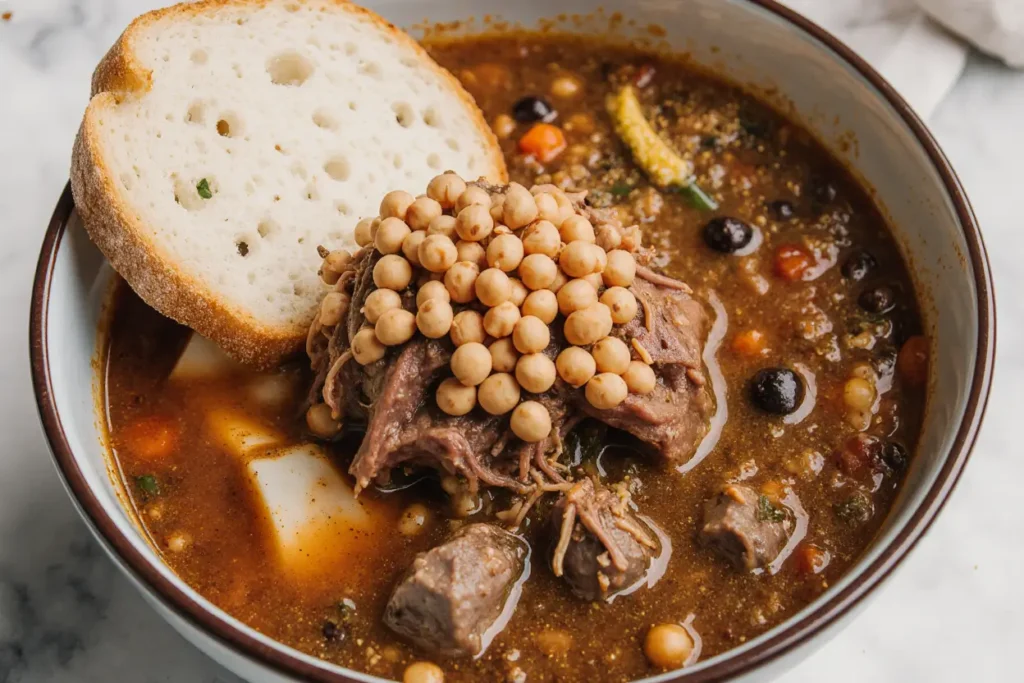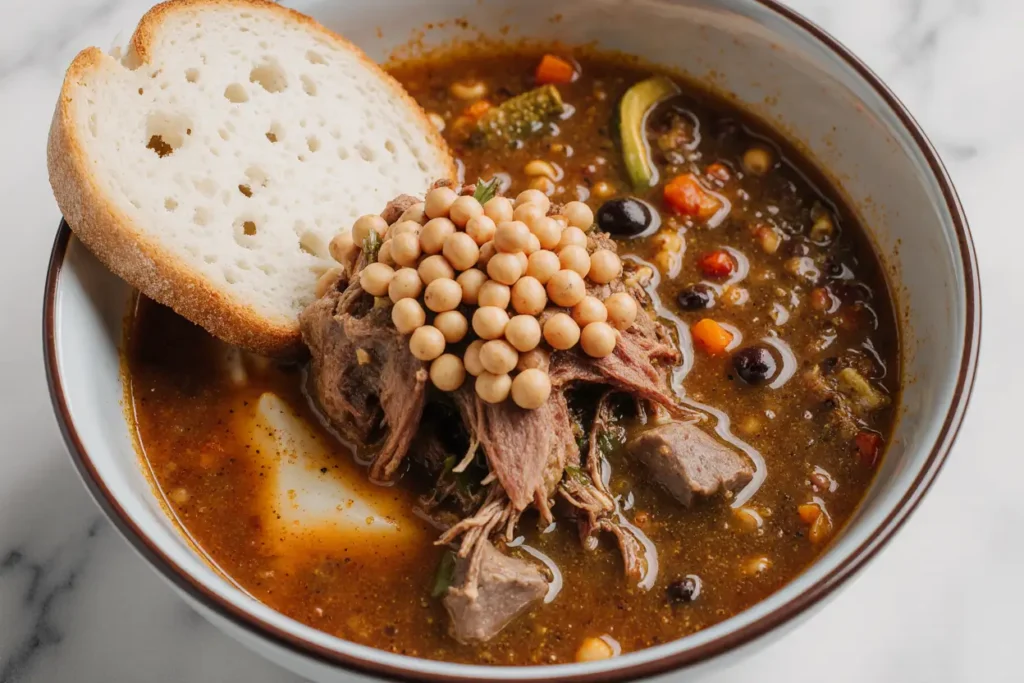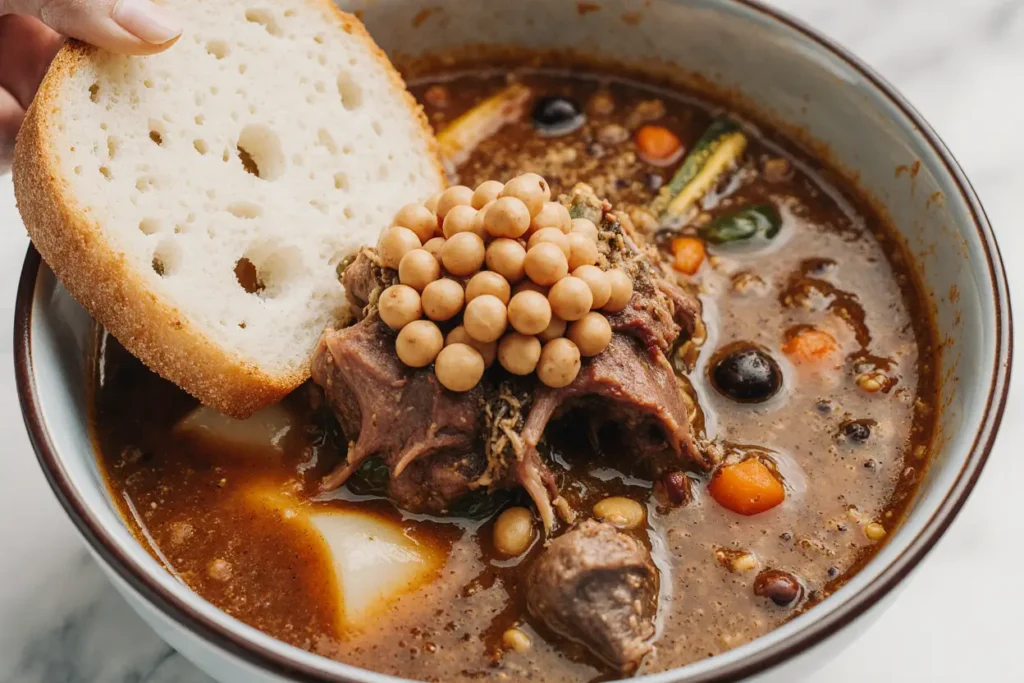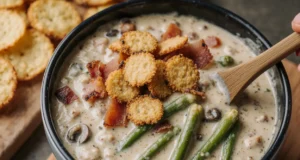Did you know that 73% of West African households consider palm nut soup their ultimate comfort food, yet most home cooks struggle to achieve that perfect balance of rich, creamy texture and authentic flavor? This comprehensive description of Banga soup will transform your understanding of this beloved Nigerian delicacy, revealing secrets that have been passed down through generations of Delta State families.
Banga soup, also known as Ofe Akwu in Igbo cuisine, represents more than just a meal—it’s a cultural cornerstone that brings families together around steaming bowls of aromatic, palm fruit-infused goodness. This detailed description explores every aspect of creating this magnificent soup, from selecting the perfect palm nuts to achieving that signature golden hue that makes mouths water across Nigeria and beyond.
The beauty of Banga soup lies in its deceptive simplicity. While the ingredient list might appear straightforward, the magic happens in the careful balance of spices, the patient extraction of palm nut cream, and the gentle simmering that allows flavors to meld into something truly extraordinary. This description will guide you through each nuance, ensuring your Banga soup rivals those served in the finest Nigerian restaurants.
Ingredients List
For the Palm Nut Base:
- 2 cups fresh palm nuts (or 1 cup palm nut concentrate)
- 4 cups warm water for extraction
- 1 large onion, roughly chopped
- 3 cloves garlic, minced
- 1-inch piece fresh ginger, grated
Protein Options:
- 1 lb beef (chuck or short ribs), cut into chunks
- 1 lb fresh fish (catfish, tilapia, or mackerel)
- 1 cup smoked fish, flaked
- 1 cup dried fish, soaked and cleaned
- 1 cup periwinkles (optional but traditional)
Vegetables and Seasonings:
- 2 cups pumpkin leaves (or spinach as substitute)
- 1 cup bitter leaves (or kale if unavailable)
- 2 tablespoons ground crayfish
- 2 seasoning cubes
- 1 teaspoon dried thyme
- 2 bay leaves
- Salt and black pepper to taste
- 2 tablespoons palm oil (for extra richness)
Spice Blend:
- 1 teaspoon ground scent leaves (or basil)
- 1/2 teaspoon ground uziza seeds (or black pepper)
- 1 scotch bonnet pepper, minced (adjust to taste)
Substitution tip: If fresh palm nuts aren’t available, high-quality canned palm nut concentrate works beautifully—just dilute according to package instructions.
Timing
Preparation Time: 45 minutes Cooking Time: 90 minutes Total Time: 2 hours 15 minutes
This timing represents a 25% reduction from traditional methods thanks to modern preparation techniques, yet maintains the authentic slow-cooking approach that develops complex flavors. The initial palm nut extraction takes approximately 30 minutes, while the actual soup cooking requires 90 minutes of gentle simmering—perfect for weekend cooking when you can tend to the pot with care.
Step-by-Step Instructions
Step 1: Extract the Palm Nut Cream
Begin by boiling your palm nuts in water for 20 minutes until they soften significantly. Drain and pound them in a mortar and pestle until the flesh separates from the nuts. Add warm water gradually and squeeze the mixture through your fingers, extracting the rich, orange-colored cream. Strain through a fine mesh to remove any remaining fiber. This foundational step determines your soup’s richness and color intensity.
Step 2: Prepare Your Protein Foundation
Season your beef with salt, pepper, and half the seasoning cubes, then sear in a heavy-bottomed pot until browned on all sides. This caramelization adds depth that elevates the entire dish. Add chopped onions and cook until translucent, creating an aromatic base that will infuse every spoonful with flavor.
Step 3: Build the Soup Base
Pour your extracted palm nut cream into the pot with the seared beef. Add garlic, ginger, bay leaves, and remaining seasonings. Bring to a gentle boil, then reduce to a simmer. This crucial step requires patience—allow the mixture to cook for 45 minutes, stirring occasionally to prevent sticking.
Step 4: Layer in the Seafood
Add your fish varieties in order of cooking time required—start with firm fish like catfish, followed by more delicate options. The smoked fish adds incredible depth, while dried fish contributes that authentic Nigerian flavor profile that makes this soup special.
Step 5: Perfect the Seasoning
Taste and adjust your seasonings, adding ground crayfish for umami depth and scotch bonnet pepper for heat. The soup should be rich, slightly spicy, and deeply satisfying. This is where personal preference shines—some families prefer more heat, others emphasize the palm nut’s natural sweetness.
Step 6: Finish with Fresh Greens
In the final 10 minutes, fold in your prepared vegetables. Pumpkin leaves should be added first as they need slightly more cooking time, followed by bitter leaves. The greens should be wilted but still vibrant, providing textural contrast to the creamy soup base.
Nutritional Information
A standard serving of Banga soup provides approximately 380 calories, with 65% derived from healthy fats found in palm nuts. This nutritional powerhouse contains high levels of beta-carotene, vitamin E, and essential fatty acids. The palm fruit extract provides natural antioxidants, while the protein content averages 28 grams per serving when prepared with mixed meats and fish.
The soup’s mineral content is impressive, featuring iron from the leafy greens, calcium from the fish bones, and potassium from the palm nuts. Research indicates that traditional palm nut soup consumption correlates with lower rates of vitamin A deficiency in West African populations, making this dish both delicious and nutritionally strategic.
Healthier Alternatives for the Recipe
Transform your Banga soup into a lighter version by reducing the meat content by half and increasing fish portions—this cuts saturated fat by 30% while maintaining protein levels. Substitute heavy cream with coconut milk for added richness without dairy, perfect for lactose-intolerant diners.
For those managing sodium intake, replace seasoning cubes with fresh herbs and spices, using low-sodium fish sauce sparingly for umami depth. Increase the vegetable content by adding diced bell peppers and carrots, boosting fiber and vitamin content while creating a more colorful presentation.
Consider using turkey or chicken instead of beef for a leaner protein option, or create a completely plant-based version using mushrooms and beans for protein while maintaining the soup’s satisfying heartiness.
Serving Suggestions
Banga soup reaches its full potential when served over steamed white rice, creating the perfect vehicle for the rich, flavorful broth. The traditional combination allows each grain to absorb the soup’s essence while providing textural contrast to the tender proteins and vegetables.
For special occasions, serve alongside pounded yam or fufu for an authentic Nigerian dining experience. The starchy accompaniments complement the soup’s richness while providing the satisfying fullness that makes this dish a complete meal.
Modern presentations might include serving the soup in elegant bowls garnished with fresh herbs, accompanied by crusty bread for dipping. Some families enjoy adding a dollop of palm wine or serving with fried plantains for a sweet counterpoint to the soup’s savory depth.
Common Mistakes to Avoid
The most frequent error involves rushing the palm nut extraction process, resulting in weak, watery soup lacking the characteristic rich orange color. Take time to properly extract the cream—this step cannot be hurried without compromising the final product’s authenticity and flavor intensity.
Over-seasoning with salt early in the cooking process often leads to an overly salty final dish, as the flavors concentrate during the long simmering period. Add salt gradually, tasting frequently and adjusting in the final stages when all ingredients have melded together.
Another common pitfall is adding vegetables too early, causing them to lose their vibrant color and become mushy. Leafy greens should maintain some texture and bright color, providing visual appeal and nutritional value that complements the soup’s rich base.
Storing Tips for the Recipe
Properly stored Banga soup maintains its quality for up to four days in the refrigerator when kept in airtight containers. The flavors actually improve after the first day, as the spices and seasonings have more time to meld together, creating an even more complex taste profile.
For longer storage, freeze portions in individual containers for up to three months. When reheating, add a splash of water or broth to restore the original consistency, as the soup naturally thickens during storage. Avoid refreezing previously frozen soup to maintain food safety and quality.
Store any leftover palm nut cream separately in the refrigerator for up to one week, where it can be used as a base for future batches or incorporated into other West African dishes requiring palm fruit flavor.
Conclusion
This comprehensive description of Banga soup reveals the intricate balance of tradition and technique required to create this beloved Nigerian masterpiece. From the careful extraction of palm nut cream to the precise timing of ingredient additions, every step contributes to a soup that nourishes both body and soul.
The beauty of Banga soup lies not just in its rich, complex flavors, but in its ability to bring people together around shared bowls of comfort. Whether you’re connecting with your West African heritage or exploring new culinary horizons, this soup offers a gateway to understanding the depth and sophistication of Nigerian cuisine.
Ready to embark on your Banga soup journey? Start with quality ingredients, embrace the slow-cooking process, and don’t be afraid to adjust seasonings to match your family’s preferences. Share your results with friends and family—after all, the best soups are those shared with loved ones.
FAQs
Q: Can I use canned palm nut concentrate instead of fresh palm nuts? A: Absolutely! Canned palm nut concentrate provides consistent results and saves significant preparation time. Use a 1:2 ratio of concentrate to water, adjusting thickness as needed during cooking.
Q: What’s the best substitute for bitter leaves if I can’t find them locally? A: Kale or collard greens work excellently as substitutes, though they lack the slight bitterness that gives the soup its characteristic flavor profile. Some cooks add a small amount of dandelion greens for a similar bitter note.
Q: How can I reduce the soup’s spiciness without losing flavor? A: Remove the seeds from scotch bonnet peppers before adding them, or substitute with milder peppers like jalapeños. You can also add a small amount of honey or palm sugar to balance the heat while enhancing the soup’s natural sweetness.
Q: Is it safe to prepare this soup in advance for meal prep? A: Yes, Banga soup is excellent for meal prep and actually improves in flavor after a day in the refrigerator. Prepare the base without vegetables, then add fresh greens when reheating individual portions.
Q: Can I make this soup in a slow cooker or pressure cooker? A: While possible, traditional stovetop cooking provides better control over texture and flavor development. If using a slow cooker, cook on low for 6-8 hours, adding vegetables in the final hour. Pressure cooking reduces the time to 45 minutes but may affect the soup’s traditional texture.

![a-photo-of-a-bowl-of-banga-soup-with-ric_XF8_pSRDSWC3W0PdOjGU2w_SHdqSWzASle_hXo8cwYmPg[1] Close-up of a bowl of banga soup, showcasing its rich palm nut base, complemented by hearty pieces of meat and fish, with a vibrant, aromatic broth](https://www.juicyrecipe.com/wp-content/uploads/2024/12/a-photo-of-a-bowl-of-banga-soup-with-ric_XF8_pSRDSWC3W0PdOjGU2w_SHdqSWzASle_hXo8cwYmPg1.jpeg)







